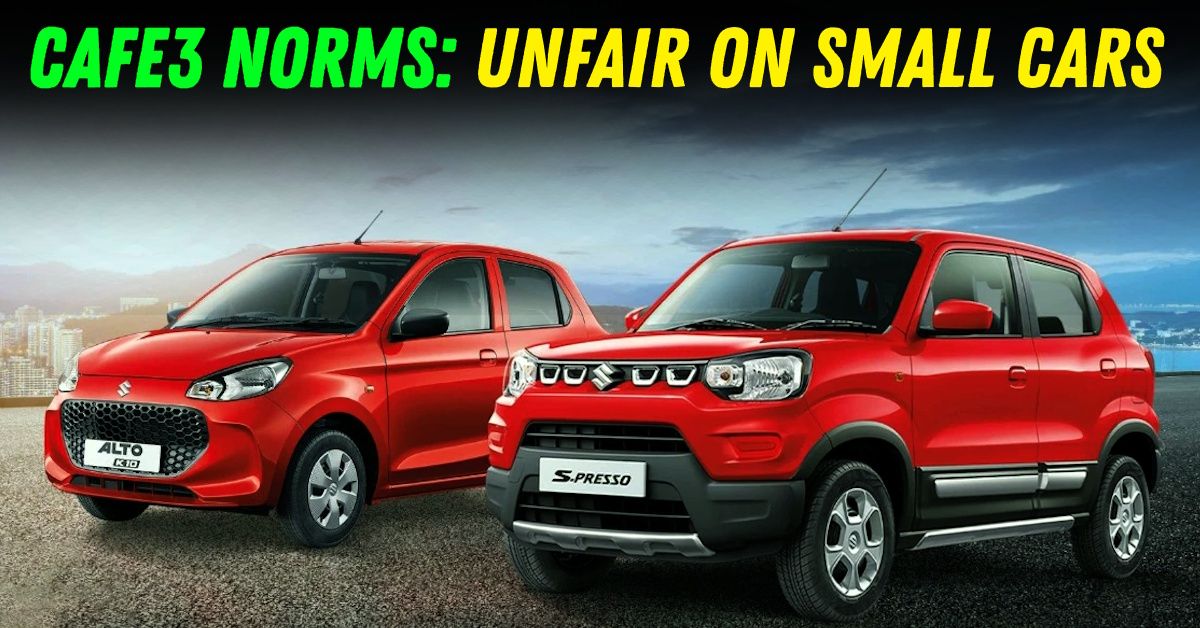CAFE3 Norms Unfair On Small Cars: We Explain Why


Small cars, once the most affordable way for families to buy a vehicle, are now facing a big challenge. A new rule, called CAFÉ 3, will come into effect in April 2027. This rule could make it much harder, and more expensive, for carmakers to keep selling small petrol cars in India. If nothing changes, many carmakers might stop making them altogether.
CAFÉ stands for Corporate Average Fuel Efficiency. The third version of this rule will require car companies to lower their average carbon dioxide (CO₂) emissions from 113 grams per kilometre to just 91.7 grams.
But the rule works in a strange way. It sets easier targets for heavier vehicles, like big SUVs, and tougher rules for lighter ones, like small cars. For example, a heavy diesel SUV that emits 128 grams of CO₂ per kilometre could still pass the test, but a light petrol car emitting just 97 grams might fail.
So, the rule ends up punishing small, fuel-efficient cars while letting bigger, more polluting vehicles off the hook.
Maruti Suzuki, India’s largest carmaker, is leading the protest against this rule. It sells many small cars like the Alto, S-Presso, WagonR, and Swift—all weighing under 1,000 kg. Because of their low weight, these models face stricter emission rules than bigger cars.
Rahul Bharti, a top executive at Maruti, says this system is unfair. “It punishes cars that are light and efficient,” he argues. Maruti wants a separate rule for small cars so they are not forced out of the market.
But other carmakers, including Tata Motors, Mahindra, MG Motor, and Toyota, don’t agree. They say having different rules for different cars will only create confusion and give unfair advantages.
Sales of small cars have dropped sharply. In 2016, India sold around 1 million small cars. In 2025, that number was just 25,000. Their market share has fallen from 47% to under 28% in just a few years.
Why? Mainly because prices have doubled. Six years ago, a basic small car cost ₹2.5 lakh. Now, it costs around ₹5 lakh. For most families, that’s too expensive. Only 12% of households in India earn more than ₹12 lakh a year. At this rate, owning a car is becoming impossible for many.
There’s also a safety angle. India has over 250 million two-wheelers on the road. Nearly half of all road deaths involve two-wheeler riders. Moving to safer four-wheelers could save many lives.
In contrast, other big countries support small cars. The US, China, Japan, and South Korea have rules that are easier on smaller vehicles. Europe, too, has changed its rules. Earlier, it gave more freedom to heavier vehicles. Now, it has flipped the rule to make heavier cars meet tougher targets.
These countries realise that penalising lightweight vehicles harms both the environment and buyers. Many have switched to a system based on a car’s footprint (its size on the road) instead of weight. This method encourages carmakers to keep cars light without punishing them unfairly.
CAFÉ 3 is also seen as a way to push carmakers towards electric vehicles (EVs). Some experts say it is nearly impossible to meet the new standards without selling EVs. But EVs are still expensive, and their sales are low - only 2.4% of all passenger vehicle sales in India.
This creates a problem. Companies that make small, low-cost cars now need to invest in expensive EV technology. And if they can’t meet the new rules, they face heavy fines - ₹25,000 per car for minor issues, and ₹50,000 for serious ones. For companies selling lakhs of cars, that adds up to hundreds of crores.
The government held a meeting in June to discuss whether small cars should get a separate rule. Some officials say there should be more support for small cars because they help more people own safe, four-wheeled vehicles.
The challenge for the government is to keep the environment clean without making cars too expensive. If the rule stays the same, carmakers might stop making small cars altogether. That would push people back to buying unsafe two-wheelers.
The final decision will show whether small cars have a future or not. If the rule changes to support them, more families will be able to buy safe, affordable cars. If not, the small car might disappear from Indian roads.
This issue is bigger than just business or profits. It’s about road safety, clean air, and access to transport. The next two years will decide whether small cars remain a part of India’s future, or become a thing of the past.